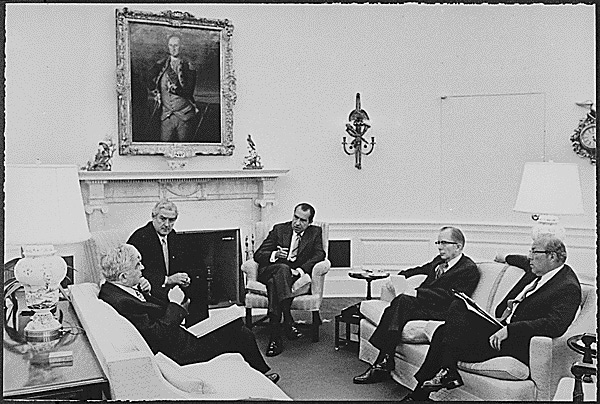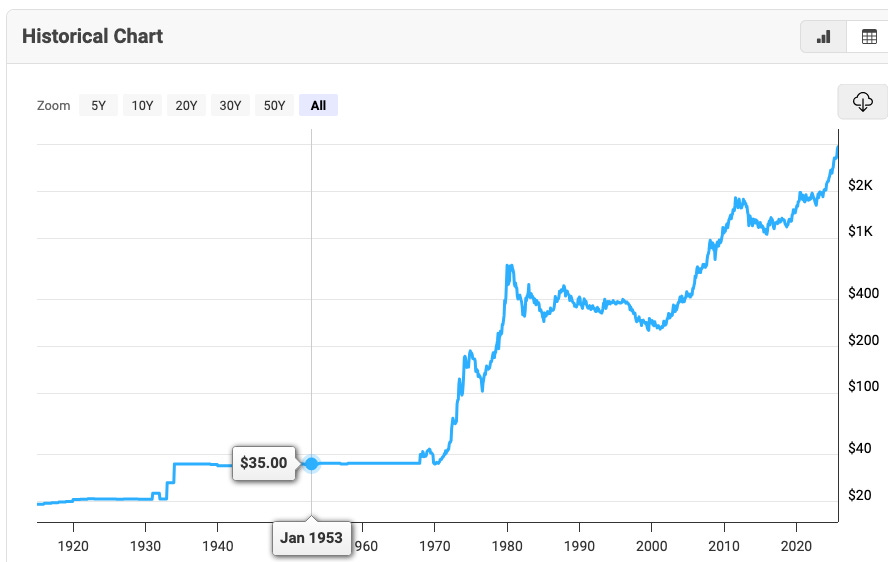What Caused the 1970s Inflation? And What Finally Cured It?
It wasn’t all about “political pressure on the Fed”

A theory has taken hold among reporters for major news organizations about the causes of inflation in the 1970s. It’s of more than merely historical interest, because the context from the past is being wielded as a weapon against further rate cuts by the Fed.
The Wall Street Journal’s reporter covering the Federal Reserve, Nick Timiraos, put it this way in a news article in today’s paper: “Central bank independence, or the freedom to take unpopular steps in the economy’s long-run interest, emerged from the lessons of the 1970s, when political pressure on the Fed contributed to runaway inflation,” Timiraos wrote.
The New York Times reporter covering the Fed, Colby Smith, has been sounding similar notes. Here’s how Smith put it in a New York Times article in July 2025:
Arthur Burns, who led the central bank from 1970 to 1978, serves as a cautionary tale for the perils of a politicized Fed. He is remembered as an ineffective chair, having bowed to political pressure by President Richard M. Nixon and unleashing one of the worst bouts of inflation in the country’s history.
Mr. Nixon, who had previously appointed Mr. Burns as an adviser, sought easier monetary policy in order to juice the economy ahead of the 1972 presidential election. What resulted was a “stop-go” approach to interest rate adjustments, with the Fed flip-flopping between raising borrowing costs and lowering them even before price pressures had been fully stamped out.
Combined with a series of geopolitical shocks that caused oil prices to spike in the late-1970s, inflation took off.
Smith at least mentions oil prices, and Timiraos hedges with “contributed to” rather than the more direct “caused.” Even so, the whole situation is a good example of how groupthink—reporters on the same beat all writing the same thing—and source capture—reporters relying on the sources at the institution they cover rather looking for more independent and original ideas—dis-serves readers and obscures the truth.
Sure, there is evidence from the Nixon White House tapes that President Nixon spoke to Fed Chairman Arthur Burns. An article by Burton A. Abrams in the Fall 2006 issue of Journal of Economic Perspectives, “How Richard Nixon Pressured Arthur Burns: Evidence from the Nixon Tapes,” gives the evidence. But the taped interactions are pretty mild—mainly Nixon musing about how he does not want to lose the 1972 election, Burns reporting back on rate cuts, and Nixon responding with praise. The most noteworthy thing in the article comes from Nixon aide John Ehrlichman’s 1982 book, Witness to Power, in which Ehrlichman describes an October 23, 1969 meeting between Nixon and Burns, who had just been nominated as Fed chair:
“My relations with the Fed,” Nixon said, “will be different than they were with [previous Federal Reserve chairman] Bill Martin there. He was always six months too late doing anything. I’m counting on you, Arthur, to keep us out of a recession.”
“Yes, Mr. President,” Burns said, lighting his pipe. “I don’t like to be late.”
Given President Trump’s nickname for Fed Chairman Jerome Powell—“too late”—it’s something to see the “too late” description used by Nixon for Bill Martin. It suggests that delayed reaction is a recurring pitfall of central banking. A lot of other things—communications, computing power—have gotten a lot faster between 1969 and 2025, but excessive slowness is still a hazard for central bankers, at least in the eyes of presidents.
The storyline that Nixon pushing the central bank to lower rates so that he could win the 1972 election is what unleashed the 1970s inflation has some problems, though. A useful primary source is Nixon’s August 15, 1971 “Address to the Nation Outlining a New Economic Policy.”
Here’s how Nixon put it in that speech: “in the 4 war years between 1965 and 1969, your wage increases were completely eaten up by price increases. Your paychecks were higher, but you were no better off. We have made progress against the rise in the cost of living. From the high point of 6 percent a year in 1969, the rise in consumer prices has been cut to 4 percent in the first half of 1971. But just as is the case in our fight against unemployment, we can and we must do better than that.”
In other words, inflation was 6 percent in 1969, before Arthur Burns took over as Fed Chair on February 1, 1970. The supposedly overly political Burns had brought it down to 4 percent. It’s almost as if the inflation were driven not by Nixonian pressure on the Federal Reserve but by Lyndon Johnson’s election-year spending binge, which brought federal outlays in 1968 to 19.8 percent of GDP—the highest since 1953—and caused a federal budget deficit of 2.8 percent of GDP, the largest since 1946, according to the historical tables maintained by the White House Office of Management and Budget.
The Reagan years showed that pro-growth policies can manage deficits, especially if the deficits come from tax cuts and defense spending rather than government waste. But the Nixon policies were the opposite of pro-growth. In the same August 15, 1971 speech, Nixon ordered “a freeze on all prices and wages throughout the United States for a period of 90 days.” He also directed the treasury secretary, John Connally, “to suspend temporarily the convertibility of the dollar into gold or other reserve assets.” Nixon claimed that, “The effect of this action, in other words, will be to stabilize the dollar,” but that might have been the biggest lie that Nixon ever told.
As a State Department history later recounted, the effect was to end the dollar’s congressionally set price of one thirty-fifth of an ounce of gold. Here’s how the State Department put it:
After months of negotiations, the Group of Ten (G–10) industrialized democracies agreed to a new set of fixed exchange rates centered on a devalued dollar in the December 1971 Smithsonian Agreement. Although characterized by Nixon as “the most significant monetary agreement in the history of the world,” the exchange rates established in the Smithsonian Agreement did not last long. Fifteen months later, in February 1973, speculative market pressure led to a further devaluation of the dollar and another set of exchange parities. Several weeks later, the dollar was yet again subjected to heavy pressure in financial markets; however, this time there would be no attempt to shore up Bretton Woods. In March 1973, the G–10 approved an arrangement wherein six members of the European Community tied their currencies together and jointly floated against the U.S. dollar, a decision that effectively signaled the abandonment of the Bretton Woods fixed exchange rate system in favor of the current system of floating exchange rates.
The December 1971 dollar was set at $38 per ounce of gold; by 1973 it was ostensibly $42 per ounce of gold, but the market wasn’t going along. The chart tells the story:

These were decisions made by presidents and treasury secretaries and to some degree Congress. Interest rates set by the Federal Reserve were much less of a factor. It took a pro-growth administration to finally defeat inflation, but the main hero wasn’t so much Fed Chairman Paul Volcker but the other players. Here is the history of it:
Keep reading with a 7-day free trial
Subscribe to The Editors to keep reading this post and get 7 days of free access to the full post archives.



